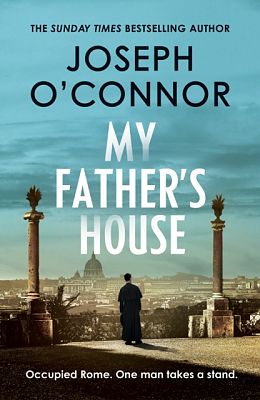
My Father’s House|Joseph O’Connor|Harvill Secker|ISBN:978178300828|£18.99
My Father’s House—the riveting story of priest Hugh O’Flaherty who prepares a place for 6,500 Allies and Jews during World War II
by Susan McKeever
Joseph O’Connor’s latest historical thriller opens with a flourish.
Looking for treatment for an injured friend in a shuttered-up Roman hospital, the protagonist, Hugh O’Flaherty, confronts a surly orderly unwilling to help, threatening to punch his teeth through his skull after revealing his priestly attire hidden under a raincoat. This is not the first time we will see the cleric lose his temper.
Monsignor Hugh O’Flaherty is no run-of-the-mill priest. He travels by motorbike, is passionate about darts, boxing and golf (having grown up on a golf course in Kerry). With three doctorates, fluency in seven languages, and a mind as sharp as ‘a lawnmower blade’, the man does not suffer fools.
He works for the Vatican during the Nazi occupation of Rome in September 1943; two years earlier he had served as official Vatican visitor to the Italian concentration camps for British prisoners of war, where he witnessed scenes that ‘took five years from my life in as many hours’.
This experience galvanises O’Flaherty into actively helping prisoners of war and Jews in Rome, and instantly changes his allegiance from neutral to passionately anti-Nazi.
On being banned from further compassionate visits to the camps by no less than the Pope himself, he moves his resistance underground. It’s to be discreet, nothing formal. He thinks of a cover for it: a choir, made up of a number of trusted friends in the city.
Haunted
Throughout the story we are haunted by O’Flaherty’s arch-nemesis, Gestapo chief of Rome Paul Hauptmann. Cold as ice, with torture rooms set up in his Via Tasso Headquarters, Hauptmann is obsessed with bringing the tenacious priest down, even visiting for confession and, in the darkened box, threatening to crack his ‘Escape Line’ which he claims he has knowledge of. Quietly, the monsignor retorts: ‘I am not afraid of you.’
The Choir begins to meet in the lead up to Christmas Eve 1943, when an ambitious ‘Rendimento’ or mission is planned to move ‘books’ (POWs) stashed in various ‘libraries’ (hiding places) out of Italy to the safety of Switzerland.
The narrative’s pace is moderated from the frantic lead-up to the Christmas Eve mission by imagined transcripts from BBC interviews of the choristers recorded in the Sixties, where members look back on the events and speak about O’Flaherty. These flesh out the personalities of the ‘cast’, which includes Sir D’Arcy Osborne, British Ambassador to the Vatican, and Delia Kiernan, singer and wife to the Irish Ambassador in Rome at the time.
Riveting
It is not an easy read, demanding back-and-forth checking from this reader as the story switches between times and narrators, as well as inter-office memos from Hauptmann ramping up the surveillance of ‘that nuisance of a priest’.
But it is riveting, and well worth the focus—and the fact that it’s based on a true story hugely amplifies the investment.
Tall, sporty, fearless, with a shock of black hair and a ruddy complexion, O’Flaherty is portrayed as a swashbuckling hero. I found myself picturing a film made of the story – a younger Liam Neeson as Hugh, maybe; Michael Fassbender as Hauptmann. I’ve since discovered a film was made – The Scarlet and the Black in 1983 starring Gregory Peck as Hugh and Christopher Plummer as Hauptmann. Perfect casting.

Susan McKeever is an editor, writer and ghostwriter for several Irish and international publishers and authors. She works from her home in the red-brick heart of Dublin’s Portobello. @MckeeverSusan, susanmckeever.biz













